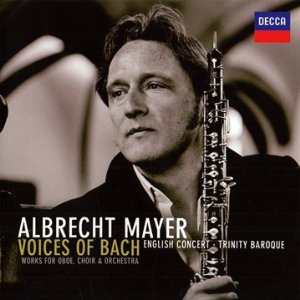 |
 |
|


alternatively
CD:
AmazonUK
AmazonUS
|
Johann Sebastian BACH (1685-1750)
Voices of Bach - Works for oboe, choir and orchestra
Chorales
Was Gott tut, das ist wohlgetan (from BWV 75) [1:42]
Jesus bleibet meine freunde (from BWV 147) [2:56]
Sei Lob und Pres mit Ehren (from BWV 167) [2:33]
Dein Blut, der edle Saft (from BWV 136) [1:22]
Ich bitte dich, Herr Jesu Christ (from BWV 166) [2:44]
Wachet auf, ruft uns die Stimme (from BWV 136) [1:22]
So fahr’ich hin zu Jesu Christ (from BWV 31) [1:13]
Was Gott tut, das ist wohlgetan (from BWV 12) [1:26]
Concertos
Concerto for oboe d’amore, continuo and strings (from BWV 209) [18:59]
Concerto for cor anglais, continuo and strings (from BWV 54) [9:42]
Concerto for oboe, continuo and strings (from BWV 105, 170, 49) [18:27]
 Albrecht Mayer (oboe, oboe d’amore, cor anglais, conductor) Albrecht Mayer (oboe, oboe d’amore, cor anglais, conductor)
Trinity Baroque/Julius Podger
The English Concert
rec. St Paul’s Church, Deptford, London, March 2009
 DECCA 478 1517 [65:20] DECCA 478 1517 [65:20] 
|
|
|
Albrecht Mayer is the principal oboe of the Berlin Philharmonic
and has already made a solo album featuring the music of Venice (Decca
4780313).
This disc takes him to the music of Bach, a body of work he
describes as his “musical home”. It is the approach
that may interest collectors more than the playing, though.
Mayer, working
with Andreas Tarkmann, has chosen a number of works which Bach
did not originally write for oboe and has turned them into
oboe showcases. The chorales, for example, all give the oboe
an artificially
prominent part, most famously taking over the string part in Jesu
Joy and Wachet auf. He takes two solo cantatas (BWV
209 and 54) and substitutes the oboe for the vocal line and,
more radically, bowdlerises three cantatas to make an entirely
new concerto. Either you’ll buy into this approach or you
won’t, in which case this disc is not for you, but before
we become too sniffy about it it’s worth remembering that
Bach himself wasn’t above doing this to his own works.
He famously made arrangements of Vivaldi’s concertos for
his own societies to play. My view is that there is far more
good than bad here and that if you like the sound of the oboe
then you’ll quickly warm to this disc.
Mayer tries to suggest that his choice of cantatas has been
to form a cycle, but if there’s a greater meaning here
then it was lost on me. He is lucky to have the impeccable
voices
of Trinity Baroque to assist him and they make a lovely sound.
However the blend with the oboe is not always well matched
and the acoustic tends to spotlight the voices too much so
that at
times it feels a little like a contest. Some of the oboe substitutions
work better than others: Jesu Joy is familiar to most
of us in an oboe arrangement anyway, and So fahr’ich
hin zu Jesu Christ works brilliantly, partly because the
oboe simply undulates silkily underneath the unaccompanied choir.
The setting of the familiar Wachet auf jars, however,
and in BWV 136 I found the oboe distracting rather than devotional.
It is, in fact, where Mayer has deviated furthest from Bach’s
purpose that he is most successful. The pungent oboe d’amore
of BWV 209 is lovely and BWV 54 works spectacularly well, the
dark tones of the cor anglais making a most convincing substitute
for the alto voice that most often takes this cantata. There
is less integrity to the mixed concerto but it works better
than you might think, especially the slow movement adapted
from BWV
170, and the blithe dance that ends it works as a great finale.
The playing itself is sleek and, to my ears, more Romantic than
Baroque, but then integrity has rather been thrown out the window
in the planning of this disc so who cares? The English Concert
are fully at home in this music but they sound a little abrasive
in the quicker movements, something not entirely made up for
in the lovely Adagios.
A good one to try, then, but go into it with your eyes open.
Simon Thompson
|
|

